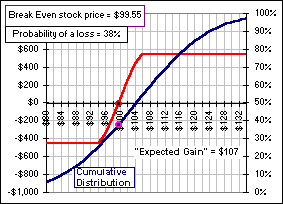| Call Option Strategies a continuation of Part II |
Here's what we'll do:
- Assume a Return R = 0.10 (meaning 10%) and Standard Deviation S = 0.25 (meaning 25%) for some stock.
- Assume we're interested in some strategy (Bull Spread? Butterfly? Condor?) involving
Call Options
which expire in N = 180 days. - We calculate the losing range of stock prices: the range of stock prices where we lose money.
- With these three parameters (R, S and N) - and some assumption concerning the distribution of returns (normal? lognormal?) - we create a probability distribution for the stock prices after N days (at expiry).
- From this distribution of prices (at expiry of our Option) we determine the probability that
the
stock price lies in the losing range. - We change the strategy (Bull Spread? Butterfly? Condor?) and keep our eye on the Probability of Losing.
Okay. Suppose the distribution of prices, at expiry, is as shown in Fig. 1 and suppose, further, that stock prices below $27 will cause us to lose money.
From this Cumulative Distribution chart  note that stock prices will be in this losing range 29% of the time. So, we'll go through some popular strategies 

 and see what the probabilities are, for success ... |  Figure 1 |
>And the probability of losing, eh?
Yes, and in particular ...
|
>Go for it! Okay, here's a picture (Fig. 2) with a Bull Spread:
|  Figure 2 |
>You invented the option premiums, the $11.65 and $7.10?
Well, I'm assuming a 10% Annual Return, a 20% Standard Deviation, a 4% Risk-free Rate, 200 days to expiration and I've used Black-Scholes and ...
>And the distribution?
I've assumed a Normal distribution and ...
>Is that valid? I mean, doesn't Black-Scholes assume a Log-normal distribution?
Well ... yes, but I'm trying to demonstrate the idea of superimposing the Gain/Loss chart (for a Bull Spread, for example) with some Cumulative Distribution so that we can identify some probability of a loss.
>Why not assume a Log-normal distribution?
Yes, we could do that, but remember that everybody stares at Black-Scholes when trading in options so we accept Black-Scholes when calculating the option premium but we can assume any distribution we like for the future distribution of stock prices. It could be Normal or Log-normal or something else.
>And the probability is 38% ... for a Bull Spread?
Of course, not! It depends upon so many parameters. For example, if the Standard Deviation is increased to 25% and the time-to-expiry decreased to 100 days (and we keep the Normal distribution) we'd get a higher probability of loss ... like so:

>I assume those "Gains" are for 100-share contracts?
Yes and ...
>Do you have a spreadsheet to do all this?
Uh ... give me some time ... but the spreadsheet will probably look like
this
with an explanation which looks like
this.
>Can I try it?
Sure ... such as it is!
Just RIGHT-click here and select "Save Target".
See also more on Call Options and Black-Scholes.

